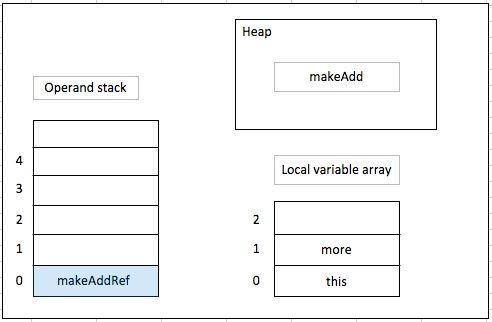摘要
本文通过 Scala 语言来实现一个简单的闭包,并且通过 Opcode 来深入理解 Scala 中闭包的实现原理。
一个简单的例子
闭包,简单的理解就是:函数内部的变量不在其作用于时,仍然可以从外部进行访问,听上去有些抽象;
下面我们来通过一个简单的例子实现 Scala 中的闭包,代码如下:
object Closures {
def main(args: Array[String]): Unit = {
val addOne = makeAdd(1)
val addTwo = makeAdd(2)
println(addOne(1))
println(addTwo(1))
}
def makeAdd(more: Int) = (x: Int) => x + more
def normalAdd(a: Int, b: Int) = a + b
}
我们定义了一个函数 makeAdd,输入参数是 Int 类型,返回的是一个函数(其实可以看成函数,后面我们会深入去研究到底是什么),同样我们定义了一个普通的函数 normalAdd 来进行比较,main 方法中,首先我们通过调用 makeAdd 来定义了两个 val:addOne 和 addTwo 并分别传入 1 和 2,然后执行并打印 addOne(1) 和 addTwo(2),运行的结果是 2 和 3。
分析
接下来我们来详细的分析一下上面这个例子的 Opcode,通过 javap 命令来查看 Closures.class 的字节码:
Last modified Feb 14, 2017; size 1311 bytes
MD5 checksum 02722b1fa1195c63a6dd0c8615db8c26
Compiled from "Closures.scala"
public final class com.learn.scala.Closures$
minor version: 0
major version: 50
flags: ACC_PUBLIC, ACC_FINAL, ACC_SUPER
Constant pool:
#1 = Utf8 com/learn/scala/Closures$
#2 = Class #1 // com/learn/scala/Closures$
#3 = Utf8 java/lang/Object
#4 = Class #3 // java/lang/Object
#5 = Utf8 Closures.scala
#6 = Utf8 MODULE$
#7 = Utf8 Lcom/learn/scala/Closures$;
#8 = Utf8
#9 = Utf8 ()V
#10 = Utf8
#11 = NameAndType #10:#9 // "":()V
#12 = Methodref #2.#11 // com/learn/scala/Closures$."":()V
#13 = Utf8 main
#14 = Utf8 ([Ljava/lang/String;)V
#15 = Utf8 makeAdd
#16 = Utf8 (I)Lscala/Function1;
#17 = NameAndType #15:#16 // makeAdd:(I)Lscala/Function1;
#18 = Methodref #2.#17 // com/learn/scala/Closures$.makeAdd:(I)Lscala/Function1;
#19 = Utf8 scala/Predef$
#20 = Class #19 // scala/Predef$
#21 = Utf8 Lscala/Predef$;
#22 = NameAndType #6:#21 // MODULE$:Lscala/Predef$;
#23 = Fieldref #20.#22 // scala/Predef$.MODULE$:Lscala/Predef$;
#24 = Utf8 scala/Function1
#25 = Class #24 // scala/Function1
#26 = Utf8 apply$mcII$sp
#27 = Utf8 (I)I
#28 = NameAndType #26:#27 // apply$mcII$sp:(I)I
#29 = InterfaceMethodref #25.#28 // scala/Function1.apply$mcII$sp:(I)I
#30 = Utf8 scala/runtime/BoxesRunTime
#31 = Class #30 // scala/runtime/BoxesRunTime
#32 = Utf8 boxToInteger
#33 = Utf8 (I)Ljava/lang/Integer;
#34 = NameAndType #32:#33 // boxToInteger:(I)Ljava/lang/Integer;
#35 = Methodref #31.#34 // scala/runtime/BoxesRunTime.boxToInteger:(I)Ljava/lang/Integer;
#36 = Utf8 println
#37 = Utf8 (Ljava/lang/Object;)V
#38 = NameAndType #36:#37 // println:(Ljava/lang/Object;)V
#39 = Methodref #20.#38 // scala/Predef$.println:(Ljava/lang/Object;)V
#40 = Utf8 this
#41 = Utf8 args
#42 = Utf8 [Ljava/lang/String;
#43 = Utf8 addOne
#44 = Utf8 Lscala/Function1;
#45 = Utf8 addTwo
#46 = Utf8 com/learn/scala/Closures$$anonfun$makeAdd$1
#47 = Class #46 // com/learn/scala/Closures$$anonfun$makeAdd$1
#48 = Utf8 (I)V
#49 = NameAndType #10:#48 // "":(I)V
#50 = Methodref #47.#49 // com/learn/scala/Closures$$anonfun$makeAdd$1."":(I)V
#51 = Utf8 more
#52 = Utf8 I
#53 = Utf8 normalAdd
#54 = Utf8 (II)I
#55 = Utf8 a
#56 = Utf8 b
#57 = Methodref #4.#11 // java/lang/Object."":()V
#58 = NameAndType #6:#7 // MODULE$:Lcom/learn/scala/Closures$;
#59 = Fieldref #2.#58 // com/learn/scala/Closures$.MODULE$:Lcom/learn/scala/Closures$;
#60 = Utf8 Code
#61 = Utf8 LocalVariableTable
#62 = Utf8 LineNumberTable
#63 = Utf8 Signature
#64 = Utf8 (I)Lscala/Function1;
#65 = Utf8 SourceFile
#66 = Utf8 InnerClasses
#67 = Utf8 ScalaInlineInfo
#68 = Utf8 Scala
{
public static final com.learn.scala.Closures$ MODULE$;
descriptor: Lcom/learn/scala/Closures$;
flags: ACC_PUBLIC, ACC_STATIC, ACC_FINAL
public static {};
descriptor: ()V
flags: ACC_PUBLIC, ACC_STATIC
Code:
stack=1, locals=0, args_size=0
0: new #2 // class com/learn/scala/Closures$
3: invokespecial #12 // Method "":()V
6: return
public void main(java.lang.String[]);
descriptor: ([Ljava/lang/String;)V
flags: ACC_PUBLIC
Code:
stack=3, locals=4, args_size=2
0: aload_0
1: iconst_1
2: invokevirtual #18 // Method makeAdd:(I)Lscala/Function1;
5: astore_2
6: aload_0
7: iconst_2
8: invokevirtual #18 // Method makeAdd:(I)Lscala/Function1;
11: astore_3
12: getstatic #23 // Field scala/Predef$.MODULE$:Lscala/Predef$;
15: aload_2
16: iconst_1
17: invokeinterface #29, 2 // InterfaceMethod scala/Function1.apply$mcII$sp:(I)I
22: invokestatic #35 // Method scala/runtime/BoxesRunTime.boxToInteger:(I)Ljava/lang/Integer;
25: invokevirtual #39 // Method scala/Predef$.println:(Ljava/lang/Object;)V
28: getstatic #23 // Field scala/Predef$.MODULE$:Lscala/Predef$;
31: aload_3
32: iconst_1
33: invokeinterface #29, 2 // InterfaceMethod scala/Function1.apply$mcII$sp:(I)I
38: invokestatic #35 // Method scala/runtime/BoxesRunTime.boxToInteger:(I)Ljava/lang/Integer;
41: invokevirtual #39 // Method scala/Predef$.println:(Ljava/lang/Object;)V
44: return
LocalVariableTable:
Start Length Slot Name Signature
0 45 0 this Lcom/learn/scala/Closures$;
0 45 1 args [Ljava/lang/String;
6 38 2 addOne Lscala/Function1;
12 32 3 addTwo Lscala/Function1;
LineNumberTable:
line 6: 0
line 7: 6
line 9: 12
line 10: 28
public scala.Function1 makeAdd(int);
descriptor: (I)Lscala/Function1;
flags: ACC_PUBLIC
Code:
stack=3, locals=2, args_size=2
0: new #47 // class com/learn/scala/Closures$$anonfun$makeAdd$1
3: dup
4: iload_1
5: invokespecial #50 // Method com/learn/scala/Closures$$anonfun$makeAdd$1."":(I)V
8: areturn
LocalVariableTable:
Start Length Slot Name Signature
0 9 0 this Lcom/learn/scala/Closures$;
0 9 1 more I
LineNumberTable:
line 13: 0
Signature: #64 // (I)Lscala/Function1;
public int normalAdd(int, int);
descriptor: (II)I
flags: ACC_PUBLIC
Code:
stack=2, locals=3, args_size=3
0: iload_1
1: iload_2
2: iadd
3: ireturn
LocalVariableTable:
Start Length Slot Name Signature
0 4 0 this Lcom/learn/scala/Closures$;
0 4 1 a I
0 4 2 b I
LineNumberTable:
line 15: 0
}
SourceFile: "Closures.scala"
InnerClasses:
public final #47; //class com/learn/scala/Closures$$anonfun$makeAdd$1
Error: unknown attribute
ScalaInlineInfo: length = 0x18
01 01 00 04 00 0A 00 09 01 00 0D 00 0E 01 00 0F
00 10 01 00 35 00 36 01
Error: unknown attribute
Scala: length = 0x0
我们先来看一下 makeAdd 部分(为了方便理解,下文中的图中只是简单的表示,类似常量池的部分并没有在图中表现出来)
首先通过 new 实例化了一个 class com/learn/scala/Closures$$anonfun$makeAdd$1,图中的 Heap 中简单的表示为 makeAdd;
dup 命令就是复制一份上一步骤分配的空间的引用,并压入 operand stack 的栈底
iload_1 就是将 LocalVariableTable 中的 more 压入 operand stack
然后 invokespecial 将栈中的两个值 pop 出来执行 init 操作,也就是将 more 的具体值传入到 makeAdd 的初始化操作的函数中(可以认为是构造函数),然后将得到的新的实例化对象的引用压入 operand stack
最后使用 areturn 返回这个引用,即将 initedmakeAddRef pop 出来
由此可以看出,Scala 中实际上是在 Heap 中创建了一个 makeAdd 的实例化对象,所以 more 变量在下次调用的时候依然可以使用,而普通方法的局部变量在调用的时候是压入 Operand stack 中的,计算完成之后就会 pop 出,所以在函数的调用完成后就不能在访问这个变量,下面我们来通过 main 方法中的具体执行来验证此结论。
我们只看关键的部分:
iconst_1:将 1 压入 operand stack
invokevirtual #18 将执行上面我们分析过的 makeAdd 函数调用的部分,调用的时候将 1 作为参数传入进行初始化,并将最终得到的实例对象的引用压入 operand stack
astore_2 将上一步骤的引用 pop 出来并存储到 Local Variable Array 中
至此执行了 main 方法中的 val addOne = makeAdd(1)
7、8、11 重复执行了上面的步骤,即代码中的第二行:val addTwo = makeAdd(2)
此时,heap 有两个对象的实例,然后后面的 15、16、17、22、25 和 31、32、33、38、41 分别执行了println(addOne(1))和println(addTwo(1))的部分,比较关键的部分是 invokeinterface 的时候执行了具体对象的 apply 方法,并将 1 作为参数传入,其它部分在此不再详细说明。
实际上我们可以在 bin 目录下看到一个名为Closures$$anonfun$makeAdd$1的类文件,我们用 javap 命令可以看到,实际上是调用了实例对象的 apply 方法:
public final int apply(int);
descriptor: (I)I
flags: ACC_PUBLIC, ACC_FINAL
Code:
stack=2, locals=2, args_size=2
0: aload_0
1: iload_1
2: invokevirtual #23 // Method apply$mcII$sp:(I)I
5: ireturn
LocalVariableTable:
Start Length Slot Name Signature
0 6 0 this Lcom/learn/scala/Closures$$anonfun$makeAdd$1;
0 6 1 x I
LineNumberTable:
line 13: 0
至此,我们验证了我们的结论,Scala 实现闭包的方法是在 heap 中保存了使用不同参数初始化而产生的不同对象,对象中保存了变量的状态,然后调用具体对象的 apply 方法而最后产生不同的结果。
结论
与 Java 中使用内部类实现闭包相比,Scala 中为函数创建了一个对象 Function1 来保存变量的状态,然后具体执行的时候调用对应实例的 apply 方法,实现了函数作用域外也可以访问函数内部的变量。
希望本文对大家有所帮助,并欢迎大家批评指正文中有可能出现的纰漏。



